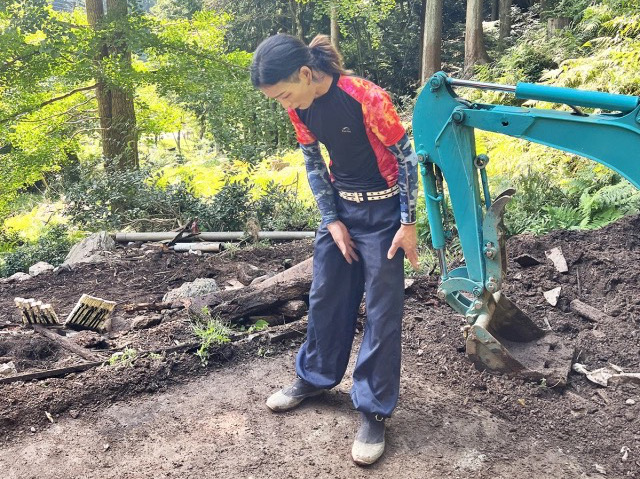
What’s the most appropriate clothing for renovating a property in Japan?
Last year, we became the proud owners of a cheap house in the Japanese countryside, which we purchased for the dirt-cheap price of US$9,100. Ever since then, we’ve been prepping the place for some much-needed renovations with the help of a friendly worker called Imazu from construction firm Hobien, and one thing we noticed about him was how he always seemed so well dressed for the job.
Dressing for the job is a big thing in Japan, even on building sites, where workers seem to have a whole fashion sense of their own. You’ll often see builders up on scaffolding, wearing long trousers that billow out from the knee, and tabi boots with a split that separates the big toe from the rest of the toes.
▼ Imazu (pictured below) also wears billowy trousers, known in the business as “knickerbockers”.
Our boss Yoshio, who usually wears jeans while working at the SoraHouse, was curious to find out what the best outfit would be for renovating a home, so after seeing Imazu in his heavily woven knickerbockers, he asked him:
▼ “Why do you wear those thick trousers?”
Yoshio was expecting Imazu to start listing all the benefits of wearing knickerbockers, but to his absolute surprise, Imazu said:
▼ “These trousers are full of disadvantages.”
According to Imazu, whose main job is landscaping, the trousers tend to get caught in branches, which often hinders his work.
Of course, Imazu did say the trousers benefit workers in other industries, such as construction, where the extra material is said to act like a cat’s whiskers, alerting the wearer to low-level obstacles that might get in their way.
However, in Imazu’s line of work, the best type of trousers for the job are actually thinner, tight-fitting ones, which Imazu often wears while working on the SoraHouse.
Imazu says he bought the knickerbockers when he was starting out and unsure about what to wear, but after years of experience he’s come to realise that they’re not always useful for his line of work. However, seeing as he now owns a pair of knickerbockers and doesn’t want them to go to waste, he still wears them occasionally, for days when he’s out of the bushes and spending most of his time on the digger.
Imazu made his preference for pants clear with this statement:
“Tighter pants with thinner cloth are really the best for me — they don’t get caught on branches, and they’re stretchy so they’re easy to move around in.”
So maybe jeans weren’t a bad choice for working on the SoraHouse after all. But what about footwear?
Imazu says he wears proper work shoes, which protect his feet when working on old buildings like ours. However, he’s not averse to traditional tabi boots, which a lot of workers wear, saying:
“Tabi have thin soles, so it’s easy to get a feel for the ground. In some situations, it can be dangerous if you don’t immediately sense that something’s amiss on the ground, so there are many people who choose to wear tabi.”
The split between the big toe and the rest of the toes on a tabi boot helps to provide extra flexibility and stability, making them particularly useful for workers who climb ladders and work on scaffolding throughout the workday.
After discussing the pros and cons of trousers and footwear, Yoshio and Imazu decided to get back to work, but when they pulled on their work gloves, they realised they actually had one thing in common.
▼ They were both wearing the same brand of gloves!
These gloves were actually recommended to our reporters as a reliable brand by Imazu’s boss, Mr Ogawa, when he came to give us an estimate on demolishing our shed.
The Showa-brand gloves are used by all workers at Hobien, regardless of their specialisation, so they’re good for all kinds of work.
So although our city slickers, who are more suited to sitting at a desk rather than a digger, might look like total newbies when it comes to their workwear, at least they’re one of the gang when it comes to their glovewear.
We’re glad to know we won’t have to invest in heavy knickerbockers and tabi boots to work at the SoraHouse, but we’re now thinking we should at least swap our sneakers for some worker’s boots, for safety’s sake. And for all our sakes, we might get Masanuki to wear something other than a swimming costume next time he visits.
Photos ©SoraNews24
● Want to hear about SoraNews24’s latest articles as soon as they’re published? Follow us on Facebook and Twitter!
[ Read in Japanese ]

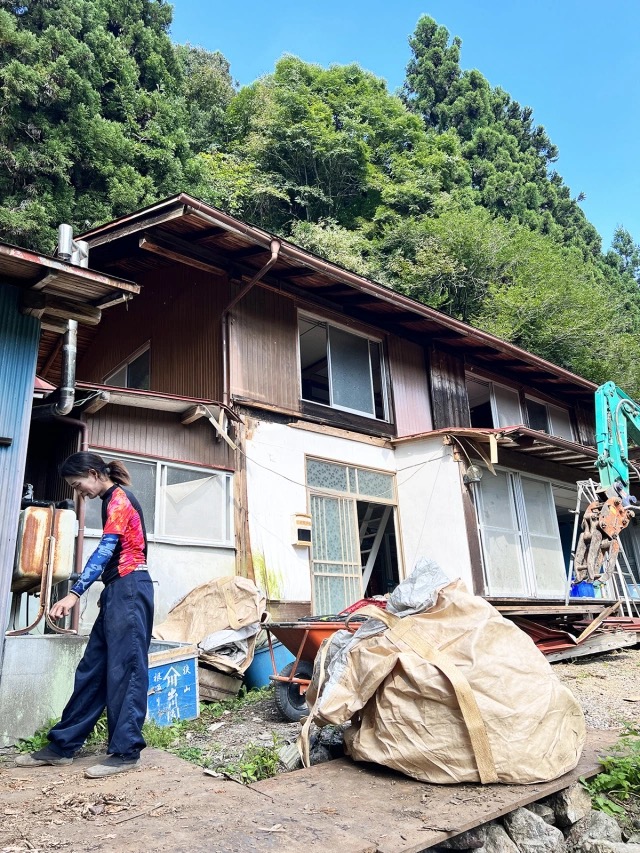
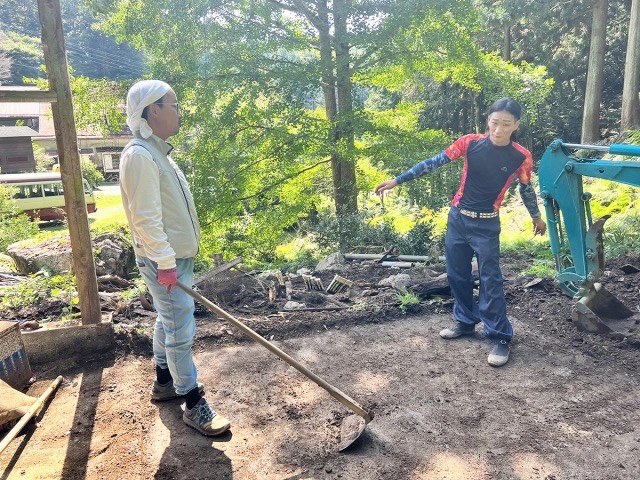

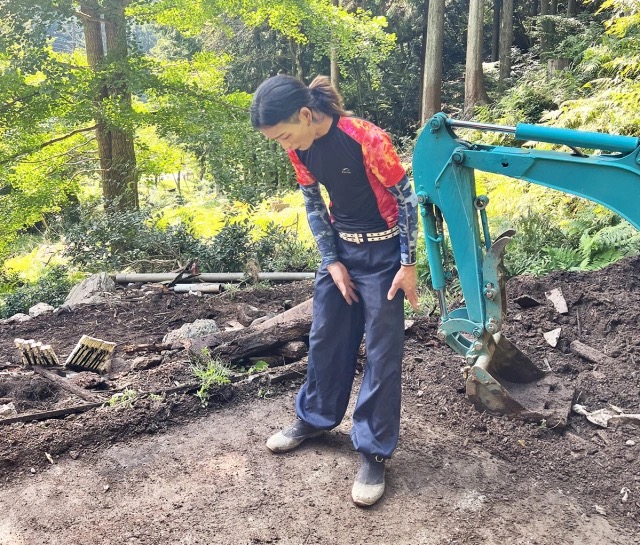
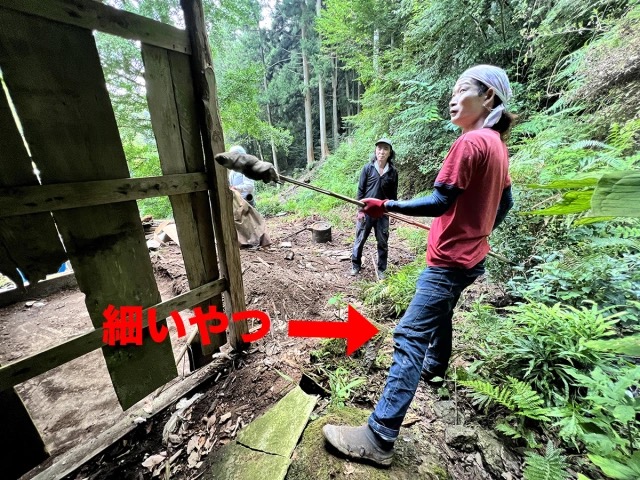
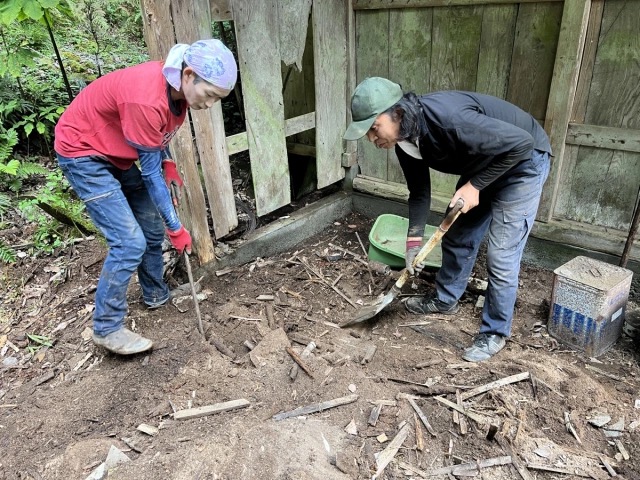
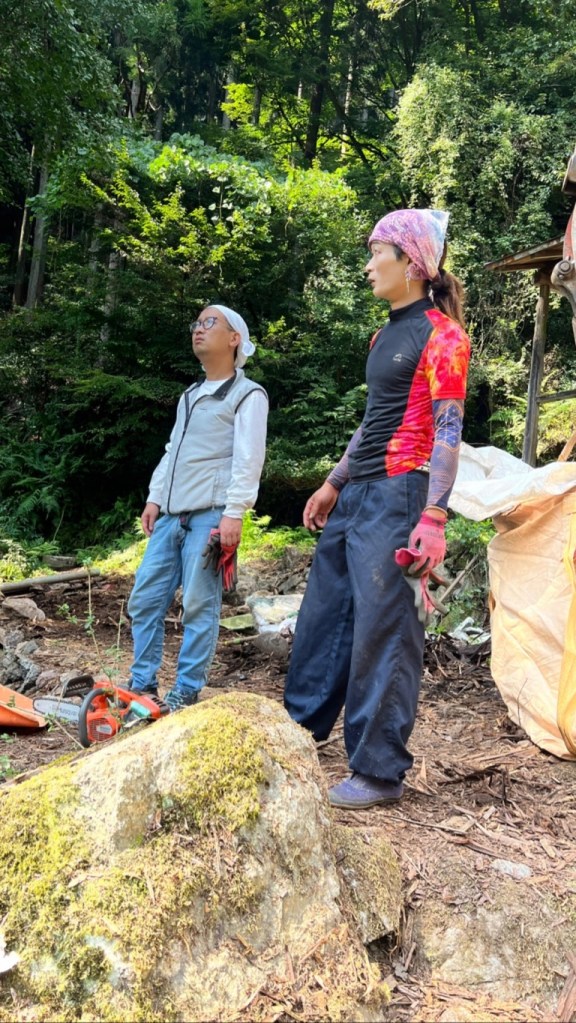
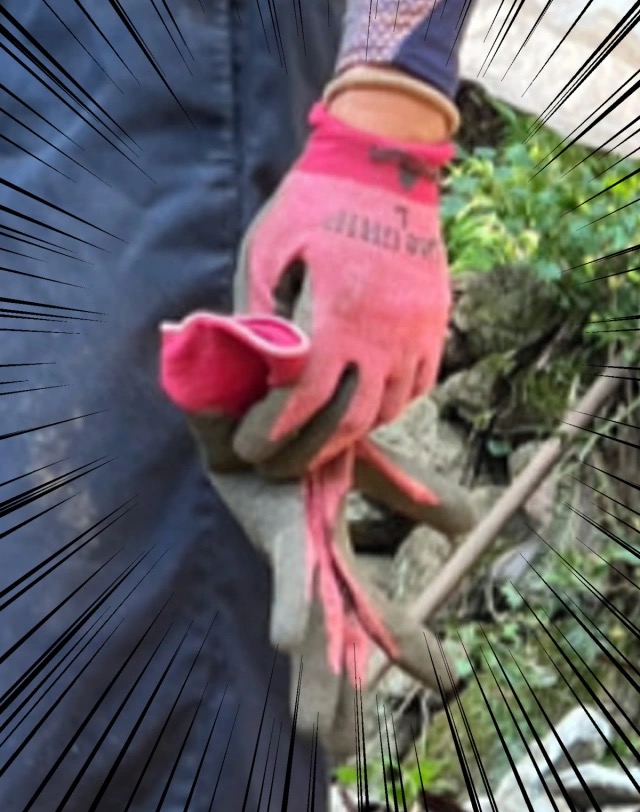
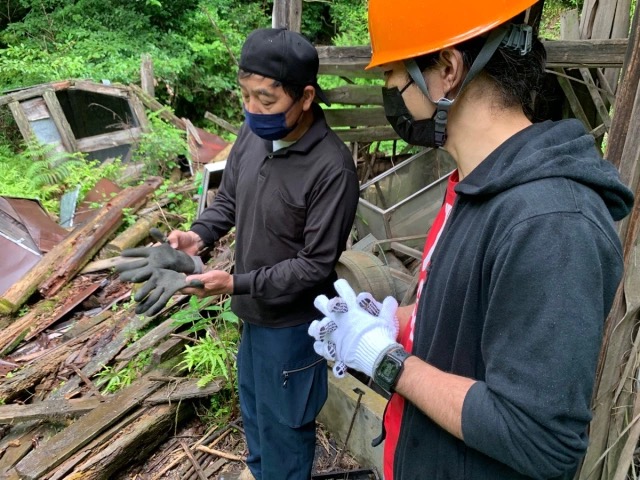
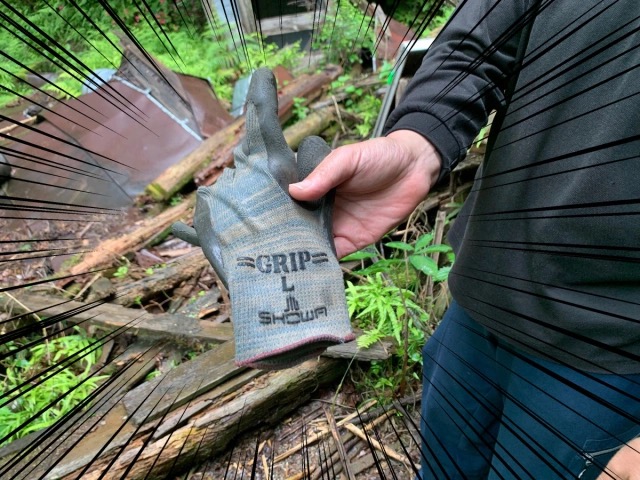
 Turning a crazy cheap country Japanese house into a home — Step 11: Dig for treasure【SoraHouse】
Turning a crazy cheap country Japanese house into a home — Step 11: Dig for treasure【SoraHouse】 Turning a crazy cheap country Japanese house into a home — Step 7: Climbing mountains【SoraHouse】
Turning a crazy cheap country Japanese house into a home — Step 7: Climbing mountains【SoraHouse】 Turning a crazy cheap country Japanese house into a home — Step 8: Roof Removal【SoraHouse】
Turning a crazy cheap country Japanese house into a home — Step 8: Roof Removal【SoraHouse】 Turning a crazy cheap country Japanese house into a home — Step 3: Dragon attack!【SoraHouse】
Turning a crazy cheap country Japanese house into a home — Step 3: Dragon attack!【SoraHouse】 Turning a crazy cheap country Japanese house into a home — Step 5: Making money【SoraHouse】
Turning a crazy cheap country Japanese house into a home — Step 5: Making money【SoraHouse】 Dragon Quest Burgers and Slime drinks are coming to McDonald’s Japan【Video】
Dragon Quest Burgers and Slime drinks are coming to McDonald’s Japan【Video】 Our writer transforms into a rock goddess in hopes of teaming up legendary musician Yoshiki 【Vid】
Our writer transforms into a rock goddess in hopes of teaming up legendary musician Yoshiki 【Vid】 How to speak Japanese like a gyaru【2024 edition】
How to speak Japanese like a gyaru【2024 edition】 X Japan’s Yoshiki, L’Arc-en-Ciel’s Hyde preview co-op theme for Attack on Titan Season 3【Video】
X Japan’s Yoshiki, L’Arc-en-Ciel’s Hyde preview co-op theme for Attack on Titan Season 3【Video】 Japanese penguin plushie takes you from egg to chick to adult bird in seconds
Japanese penguin plushie takes you from egg to chick to adult bird in seconds Hayao Miyazaki says Happy New Year to Studio Ghibli fans with new art for Year of the Horse
Hayao Miyazaki says Happy New Year to Studio Ghibli fans with new art for Year of the Horse We revisited Sweets Paradise after a decade to see if Japan’s dessert buffet still delivers
We revisited Sweets Paradise after a decade to see if Japan’s dessert buffet still delivers The mystery of the phantom “sake pass card” at Japanese alcohol vending machines
The mystery of the phantom “sake pass card” at Japanese alcohol vending machines New world’s biggest Muji just opened in Japan, and we paid it a visit【Photos】
New world’s biggest Muji just opened in Japan, and we paid it a visit【Photos】 From beef bowl to beef pouch? Taste testing Yoshinoya’s instant gyudon packs
From beef bowl to beef pouch? Taste testing Yoshinoya’s instant gyudon packs Starbucks Japan ready to get Year of the Horse started with adorable drinkware and plushies【Pics】
Starbucks Japan ready to get Year of the Horse started with adorable drinkware and plushies【Pics】 Cyberpunk anime meets traditional culture in Ghost in the Shell gold leaf Japanese changing screens
Cyberpunk anime meets traditional culture in Ghost in the Shell gold leaf Japanese changing screens 7 great places to see Mt. Fuji from without having to climb it
7 great places to see Mt. Fuji from without having to climb it Hello Kitty Choco Egg figures are an adorable trip through three periods of Japanese pop culture【Pics】
Hello Kitty Choco Egg figures are an adorable trip through three periods of Japanese pop culture【Pics】 7-Eleven Japan’s ramen-cooking robot whipped us up a bowl of noodles【Taste test】
7-Eleven Japan’s ramen-cooking robot whipped us up a bowl of noodles【Taste test】 We found possibly the quietest Japanese-style hotel in Tokyo’s bustling Shinjuku district
We found possibly the quietest Japanese-style hotel in Tokyo’s bustling Shinjuku district Japan’s otoshidama tradition of giving kids money at New Year’s gets a social welfare upgrade
Japan’s otoshidama tradition of giving kids money at New Year’s gets a social welfare upgrade Sumo Sanrio! Hello Kitty and pals team up with Japan Sumo Association for new merch【Pics】
Sumo Sanrio! Hello Kitty and pals team up with Japan Sumo Association for new merch【Pics】 More Than a Capsule Stay: Why Solo Travelers Choose “global cabin Yokohama Chinatown”
More Than a Capsule Stay: Why Solo Travelers Choose “global cabin Yokohama Chinatown” Japan’s oldest largetooth sawfish in captivity back on display in Mie Prefecture
Japan’s oldest largetooth sawfish in captivity back on display in Mie Prefecture 7-Eleven Japan starts new temporary luggage storage service in over 300 branches
7-Eleven Japan starts new temporary luggage storage service in over 300 branches Disillusionment at Tsukiji’s tourist-target prices led us to a great ramen restaurant in Tokyo
Disillusionment at Tsukiji’s tourist-target prices led us to a great ramen restaurant in Tokyo Starbucks teams up with 166-year-old Kyoto doll maker for Year of the Horse decorations【Photos】
Starbucks teams up with 166-year-old Kyoto doll maker for Year of the Horse decorations【Photos】 Tokyo considering law requiring more trash cans following litter increase in heavily touristed area
Tokyo considering law requiring more trash cans following litter increase in heavily touristed area Tokyo’s Tsukiji sushi neighborhood asks tour groups to stay away for the rest of the month
Tokyo’s Tsukiji sushi neighborhood asks tour groups to stay away for the rest of the month Tokyo event lets you travel back in time, for free, to celebrate 100 years since Showa era start
Tokyo event lets you travel back in time, for free, to celebrate 100 years since Showa era start Sanrio theme park in Japan announces plans to expand into a Sanrio resort
Sanrio theme park in Japan announces plans to expand into a Sanrio resort Japan may add Japanese language proficiency, lifestyle classes to permanent foreign resident requirements
Japan may add Japanese language proficiency, lifestyle classes to permanent foreign resident requirements Stamina-destroying “Paralysis Noodles” are Tokyo’s newest over-the-top ramen innovation
Stamina-destroying “Paralysis Noodles” are Tokyo’s newest over-the-top ramen innovation Survey asks foreign tourists what bothered them in Japan, more than half gave same answer
Survey asks foreign tourists what bothered them in Japan, more than half gave same answer Japan’s human washing machines will go on sale to general public, demos to be held in Tokyo
Japan’s human washing machines will go on sale to general public, demos to be held in Tokyo Japan’s deadliest food claims more victims, but why do people keep eating it for New Year’s?
Japan’s deadliest food claims more victims, but why do people keep eating it for New Year’s? We deeply regret going into this tunnel on our walk in the mountains of Japan
We deeply regret going into this tunnel on our walk in the mountains of Japan Studio Ghibli releases Kodama forest spirits from Princess Mononoke to light up your home
Studio Ghibli releases Kodama forest spirits from Princess Mononoke to light up your home Major Japanese hotel chain says reservations via overseas booking sites may not be valid
Major Japanese hotel chain says reservations via overseas booking sites may not be valid Put sesame oil in your coffee? Japanese maker says it’s the best way to start your day【Taste test】
Put sesame oil in your coffee? Japanese maker says it’s the best way to start your day【Taste test】 No more using real katana for tourism activities, Japan’s National Police Agency says
No more using real katana for tourism activities, Japan’s National Police Agency says Starbucks Japan reveals new sakura drinkware collection, inspired by evening cherry blossoms
Starbucks Japan reveals new sakura drinkware collection, inspired by evening cherry blossoms Updated cherry blossom forecast shows extra-long sakura season for Japan this year
Updated cherry blossom forecast shows extra-long sakura season for Japan this year Turning a crazy cheap country Japanese house into a home — Step 10: Mysterious water【SoraHouse】
Turning a crazy cheap country Japanese house into a home — Step 10: Mysterious water【SoraHouse】 Turning a crazy cheap country Japanese house into a home — Step 9: Chestnuts【SoraHouse】
Turning a crazy cheap country Japanese house into a home — Step 9: Chestnuts【SoraHouse】 Turning a crazy cheap country Japanese house into a home — Step 2: Clearing out weeds【SoraHouse】
Turning a crazy cheap country Japanese house into a home — Step 2: Clearing out weeds【SoraHouse】 Turning a crazy cheap country Japanese house into a home — Step 15: Trash to Treasure【SoraHouse】
Turning a crazy cheap country Japanese house into a home — Step 15: Trash to Treasure【SoraHouse】 Turning a crazy cheap country Japanese house into a home — Step 6: Outdoor bathing【SoraHouse】
Turning a crazy cheap country Japanese house into a home — Step 6: Outdoor bathing【SoraHouse】 Turning a crazy cheap country Japanese house into a home — Step 4: Ghost Hunting【SoraHouse】
Turning a crazy cheap country Japanese house into a home — Step 4: Ghost Hunting【SoraHouse】 Turning a crazy cheap country Japanese house into a home — Step 14: Before and After 【SoraHouse】
Turning a crazy cheap country Japanese house into a home — Step 14: Before and After 【SoraHouse】 Turning a crazy cheap country Japanese house into a home — Step 13: Mysterious pit, nasty smells
Turning a crazy cheap country Japanese house into a home — Step 13: Mysterious pit, nasty smells Turning a crazy cheap country Japanese house into a home — Step 1: Tegowashi【SoraHouse】
Turning a crazy cheap country Japanese house into a home — Step 1: Tegowashi【SoraHouse】 Tearing down the ceiling at our cheap Japanese house in the countryside【SoraHouse】
Tearing down the ceiling at our cheap Japanese house in the countryside【SoraHouse】 How to eat well at a cheap Japanese house in the countryside with no electricity【SoraHouse】
How to eat well at a cheap Japanese house in the countryside with no electricity【SoraHouse】 We buy a cheap Japanese mini van to go with our crazy cheap country house 【SoraHouse】
We buy a cheap Japanese mini van to go with our crazy cheap country house 【SoraHouse】 Turning a crazy cheap country Japanese house into a home Season 2: So much poo!【SoraHouse】
Turning a crazy cheap country Japanese house into a home Season 2: So much poo!【SoraHouse】 An unexpected visitor stops by our cheap Japanese house in the countryside【SoraHouse】
An unexpected visitor stops by our cheap Japanese house in the countryside【SoraHouse】 We accidentally turned our cheap country house into a “gaming house” for Christmas【SoraHouse】
We accidentally turned our cheap country house into a “gaming house” for Christmas【SoraHouse】 We throw a bubble party at our cheap countryside house in Japan【Video】
We throw a bubble party at our cheap countryside house in Japan【Video】
Leave a Reply